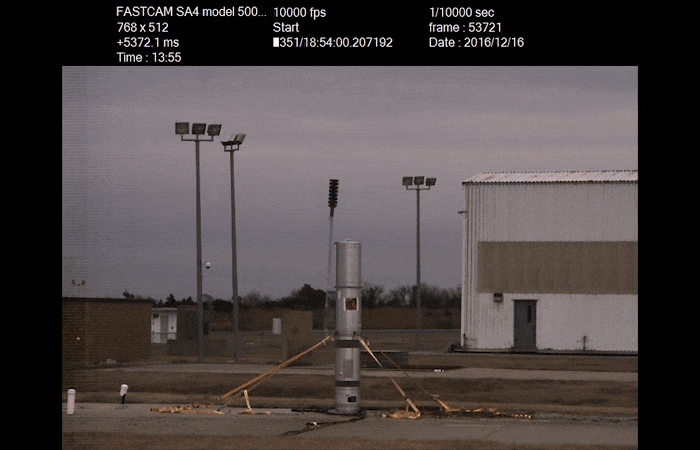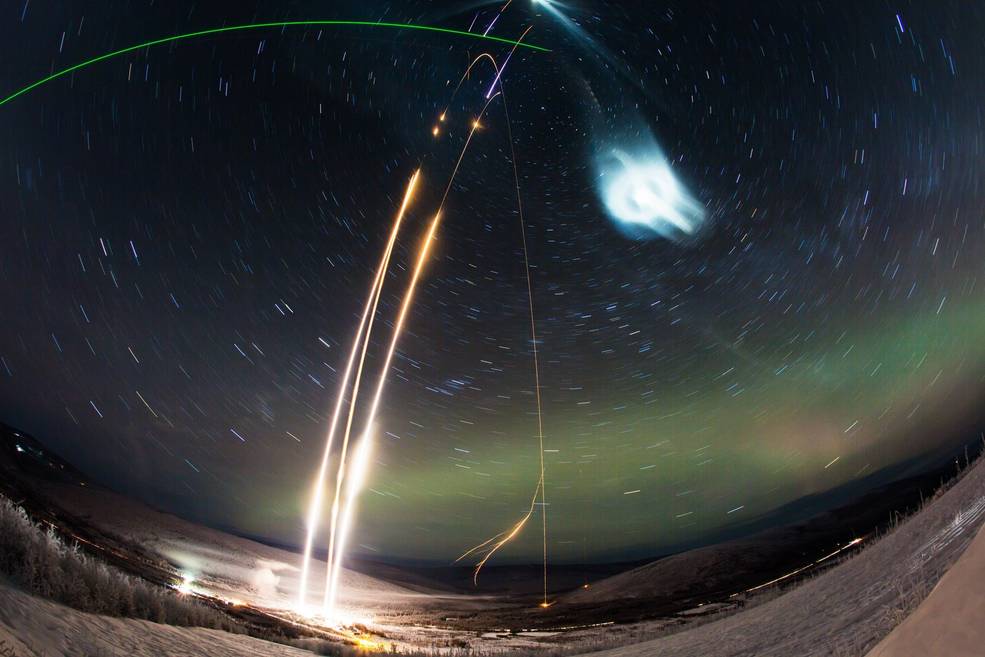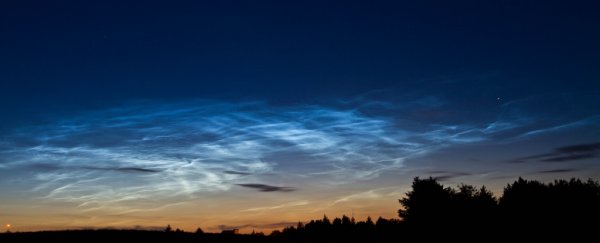If you're in the right place at the right time, and you turn your eyes to the sky, you just might catch sight of something eerily beautiful: Wisps of cloud, high in the sky, glowing softly even though the Sun has already slipped below the horizon.
These are noctilucent, or night-shining, clouds, appearing at twilight primarily in the summer months, at high latitudes (but never observed from within the polar circle). They consist of collections of ice crystals high up in the atmosphere, at mesospheric altitudes between 76 and 85 kilometres (47 to 53 miles) above Earth's surface.
These wisps are too faint to be seen during the day, but after the Sun has sunk below the horizon, its last rays reach high into the atmosphere, even though the star itself is no longer visible from the planet's surface. There, these rays light up the clouds, causing them to glow against the darkening sky. For this reason, these glowing clouds are also known as polar mesospheric clouds.
They're extraordinarily beautiful – and also potentially very scientifically useful.
"What has attracted a lot of interest in these clouds is their sensitivity – they're occurring just on the edge of viability in the upper atmosphere, where it's incredibly dry and incredibly cold," said space physicist Richard Collins of the University of Alaska, Fairbanks.
"They're a very sensitive indicator of changes in the upper atmosphere – changes in temperature and/or changes in water vapour."
Collins and his team thought that these clouds might have something to do with the presence of water vapour in the upper atmosphere. So, they did the only sensible thing: They loaded a suborbital rocket with water and shot it into the sky above Alaska to see if they could make a noctilucent cloud.
In order to make sure they weren't mixing their artificial clouds with naturally occurring ones, they chose to launch the rocket into the winter pre-dawn sky, when conditions seem to be far less conducive to natural noctilucent cloud formation than in summer.
On 26 January 2018, the Super Soaker rocket mission launched, with one sounding rocket carrying 220-kilograms (485-pounds) of water in two canisters. Two other sounding rockets flew in accompaniment, carrying trimethyl aluminium (TMA) tracers to track wind movement.
 Ground test of water release. (NASA's Wallops Flight Facility)
Ground test of water release. (NASA's Wallops Flight Facility)
At an altitude of 85 kilometres, the water was released in a tremendous whoosh. Just 18 seconds later, a laser beam from a ground-based Rayleigh LIDAR detected a faint noctilucent cloud. Over three minutes, the cloud seemed to descend from a peak altitude of 92 kilometres (57 miles) down to 78 kilometres (48 miles).
To find out what happened and why the cloud forme, the team needed to get creative. Although they had atmospheric temperature measurements, they had no direct measurements of the temperature of the cloud, so they ran simulations of noctilucent cloud formation. The simulated conditions under which the cloud formed allowed the team to infer the change in temperature that must have taken place in the experiment.
 (NASA's Wallops Flight Facility/Poker Flat Research Range/Zayn Roohi)
(NASA's Wallops Flight Facility/Poker Flat Research Range/Zayn Roohi)
Above: Timelapse of the Super Soaker launch. The green laser beam visible at the top left is the LIDAR beam used to measure the artificial cloud.
The only way that the cloud formed was by a drop in temperature of about 25 degrees Celsius (45 degrees Fahrenheit). This suggested that the presence of the water vapour itself, released from the canisters, was responsible for that temperature drop. The increase in humidity also increased the temperature of the frost point, when water vapour condenses to ice crystals.
The combination of the drop in temperature and the rise in frost point allows the two temperatures to cross over, which in turn causes the water vapour to freeze into ice crystals.
"This is the first time anyone has experimentally demonstrated that polar mesospheric cloud formation in the mesosphere is directly linked to cooling by water vapour itself," said space physicist Irfan Azeem of aerospace company Astra, LLC.
This could explain, the researchers said, why noctilucent clouds seem to follow space launches. Water vapour is a common effluent in spacecraft exhaust, and scientists have observed the connection many times in the Arctic summer.
The polar mesosphere, in summer, has what the researchers call "persistent and vigorous" upwelling, which likely carries water vapour from lower altitudes and creates the same effect the team saw in their Super Soaker experiment.
"This might explain why the formation of mesospheric clouds by space traffic is more readily observed in the summer than in the winter," they wrote in their paper.
"Nonetheless, while space traffic water exhaust serves as a reservoir for mesospheric cloud production, this study suggests that the exhaust can also actively cool the mesosphere and induces the formation of mesospheric clouds, even in the polar winter."
So noctilucent-cloud-watchers could have a new way to predict when they're going to occur: by carefully following space launch schedules.
The team's research has been published in the Journal of Geophysical Research: Space Physics.
